The Python Book
All — By Topic
2019 2016 2015 2014
angle
argsort
beautifulsoup
binary
bisect
clean
collinear
covariance
cut_paste_cli
datafaking
dataframe
datetime
day_of_week
delta_time
df2sql
doctest
exif
floodfill
fold
format
frequency
gaussian
geocode
httpserver
is
join
legend
linalg
links
matrix
max
namedtuple
null
numpy
oo
osm
packaging
pandas
plot
point
range
regex
repeat
reverse
sample_words
shortcut
shorties
sort
stemming
strip_html
stripaccent
tools
visualization
zen
zip
3d aggregation angle archive argsort atan beautifulsoup binary bisect class clean collinear colsum comprehension count covariance csv cut_paste_cli datafaking dataframe datetime day_of_week delta_time deltatime df2sql distance doctest dotproduct dropnull exif file floodfill fold format formula frequency function garmin gaussian geocode geojson gps groupby html httpserver insert ipython is join kfold legend linalg links magic matrix max min namedtuple none null numpy onehot oo osm outer_product packaging pandas plot point quickies range read_data regex repeat reverse sample sample_data sample_words shortcut shorties sort split sqlite stack stemming string strip_html stripaccent tools track tuple visualization zen zip zipfile
Convert a Garmin .FIT file and plot the heartrate of your run
Use gpsbabel to turn your FIT file into CSV:
gpsbabel -t -i garmin_fit -f 97D54119.FIT -o unicsv -F 97D54119.csvPandas imports:
import pandas as pd
import math
import matplotlib.pyplot as plt
pd.options.display.width=150Read the CSV file:
df=pd.read_csv('97D54119.csv',sep=',',skip_blank_lines=False)Show some points:
df.head(500).tail(10)
No Latitude Longitude Altitude Speed Heartrate Cadence Date Time
490 491 50.855181 4.826737 78.2 2.79 144 78.0 2019/07/13 06:44:22
491 492 50.855136 4.826739 77.6 2.79 147 78.0 2019/07/13 06:44:24
492 493 50.854962 4.826829 76.2 2.77 148 77.0 2019/07/13 06:44:32
493 494 50.854778 4.826951 77.4 2.77 146 78.0 2019/07/13 06:44:41
494 495 50.854631 4.827062 78.0 2.71 143 78.0 2019/07/13 06:44:49
495 496 50.854531 4.827174 79.2 2.70 146 77.0 2019/07/13 06:44:54
496 497 50.854472 4.827249 79.2 2.73 149 77.0 2019/07/13 06:44:57
497 498 50.854315 4.827418 79.8 2.74 149 76.0 2019/07/13 06:45:05
498 499 50.854146 4.827516 77.4 2.67 147 76.0 2019/07/13 06:45:14
499 500 50.853985 4.827430 79.0 2.59 144 75.0 2019/07/13 06:45:22Function to compute the distance (approximately) :
# function to approximately calculate the distance between 2 points
# from: http://www.movable-type.co.uk/scripts/latlong.html
def rough_distance(lat1, lon1, lat2, lon2):
lat1 = lat1 * math.pi / 180.0
lon1 = lon1 * math.pi / 180.0
lat2 = lat2 * math.pi / 180.0
lon2 = lon2 * math.pi / 180.0
r = 6371.0 #// km
x = (lon2 - lon1) * math.cos((lat1+lat2)/2)
y = (lat2 - lat1)
d = math.sqrt(x*x+y*y) * r
return dCompute the distance:
ds=[]
(d,priorlat,priorlon)=(0.0, 0.0, 0.0)
for t in df[['Latitude','Longitude']].itertuples():
if len(ds)>0:
d+=rough_distance(t.Latitude,t.Longitude, priorlat, priorlon)
ds.append(d)
(priorlat,priorlon)=(t.Latitude,t.Longitude)
df['CumulativeDist']=ds Let's plot!
df.plot(kind='line',x='CumulativeDist',y='Heartrate',color='red')
plt.show() 
Or multiple columns:
plt.plot( df.CumulativeDist, df.Heartrate, color='red')
plt.plot( df.CumulativeDist, df.Altitude, color='blue')
plt.show()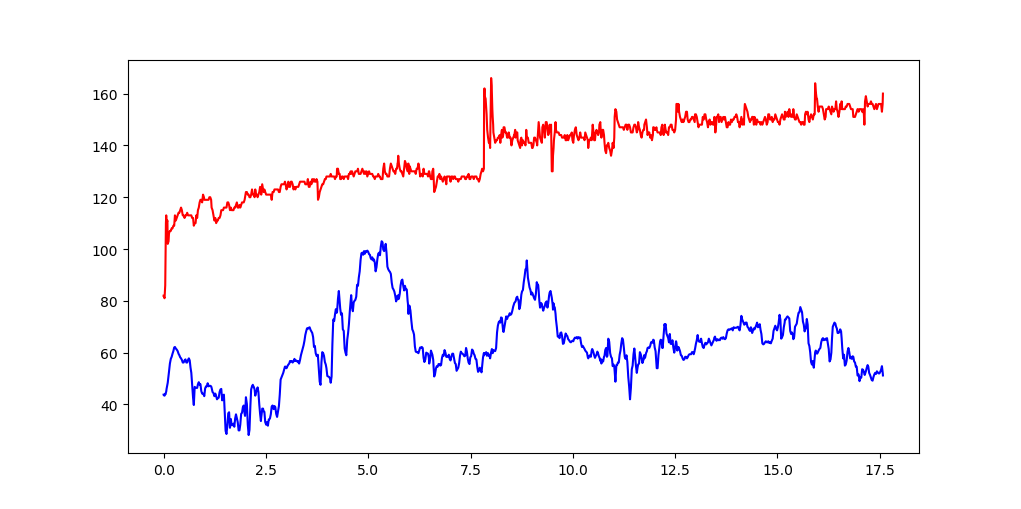
Pie chart
Make a pie-chart of the top-10 number of cities per country in the file cities15000.txt
import pandas as pd
import matplotlib.pyplot as pltLoad city data, but only the country column.
colnames= [ "country" ]
df=pd.io.parsers.read_table("/usr/share/libtimezonemap/ui/cities15000.txt",
sep="\t", header=None, names= colnames,
usecols=[ 8 ])Get the counts:
cnts=df['country'].value_counts()
total_cities=cnts.sum()
22598Keep the top 10:
t10=cnts.order(ascending=False)[:10]
US 2900
IN 2398
BR 1195
DE 986
RU 951
CN 788
JP 752
IT 674
GB 625
FR 616What are the percentages ? (to display in the label)
pct=t10.map( lambda x: round((100.*x)/total_cities,2)).values
array([ 12.83, 10.61, 5.29, 4.36, 4.21, 3.49, 3.33, 2.98, 2.77, 2.73])Labels: country-name + percentage
labels=[ "{} ({}%)".format(cn,pc) for (cn,pc) in zip( t10.index.values, pct)]
['US (12.83%)', 'IN (10.61%)', 'BR (5.29%)', 'DE (4.36%)', 'RU (4.21%)', 'CN (3.49%)',
'JP (3.33%)', 'IT (2.98%)', 'GB (2.77%)', 'FR (2.73%)']Values:
values=t10.values
array([2900, 2398, 1195, 986, 951, 788, 752, 674, 625, 616])Plot
plt.style.use('ggplot')
plt.title('Number of Cities per Country\nIn file cities15000.txt')
plt.pie(values,labels=labels)
plt.show()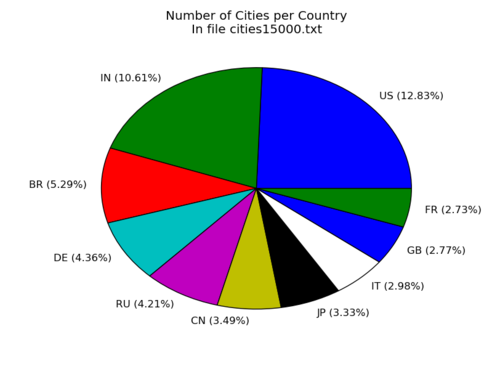
Plot a couple of Gaussians
import numpy as np
from math import pi
from math import sqrt
import matplotlib.pyplot as plt
def gaussian(x, mu, sig):
return 1./(sqrt(2.*pi)*sig)*np.exp(-np.power((x - mu)/sig, 2.)/2)
xv= map(lambda x: x/10.0, range(0,120,1))
mu= [ 2.0, 7.0, 9.0 ]
sig=[ 0.45, 0.70, 0.3 ]
for g in range(len(mu)):
m=mu[g]
s=sig[g]
yv=map( lambda x: gaussian(x,m,s), xv )
plt.plot(xv,yv)
plt.show()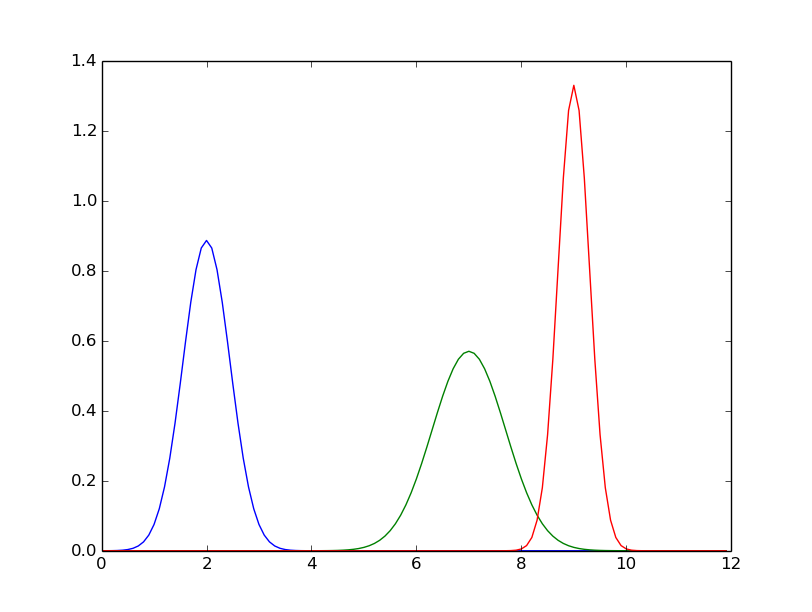
Plot with simple legend
Use 'label' in your plot() call.
import math
import matplotlib.pyplot as plt
xv= map( lambda x: (x/4.)-10., range(0,81))
for l in [ 0.1, 0.5, 1., 5.] :
yv= map( lambda x: math.exp((-(-x)**2)/l), xv)
plt.plot(xv,yv,label='lambda = '+str(l));
plt.legend()
plt.show()
Sidenote: the function plotted is that of the Gaussian kernel in weighted nearest neighour regression, with xi=0
A good starting place:
matplotlib.org/mpl_toolkits/mplot3d/tutorial.html
Simple 3D scatter plot
Preliminary
from mpl_toolkits.mplot3d import axes3d
import matplotlib.pyplot as plt
import numpy as npData : create matrix X,Y,Z
X=[ [ i for i in range(0,10) ], ]*10
Y=np.transpose(X)
Z=[]
for i in range(len(X)):
R=[]
for j in range(len(Y)):
if i==j: R.append(2)
else: R.append(1)
Z.append(R)X:
[[0, 1, 2, 3, 4],
[0, 1, 2, 3, 4],
[0, 1, 2, 3, 4],
[0, 1, 2, 3, 4],
[0, 1, 2, 3, 4]]Y:
[[0, 0, 0, 0, 0],
[1, 1, 1, 1, 1],
[2, 2, 2, 2, 2],
[3, 3, 3, 3, 3],
[4, 4, 4, 4, 4]])Z:
[[2, 1, 1, 1, 1],
[1, 2, 1, 1, 1],
[1, 1, 2, 1, 1],
[1, 1, 1, 2, 1],
[1, 1, 1, 1, 2]]Scatter plot
fig = plt.figure()
ax = fig.add_subplot(111, projection='3d')
ax.scatter(X, Y, Z)
plt.show()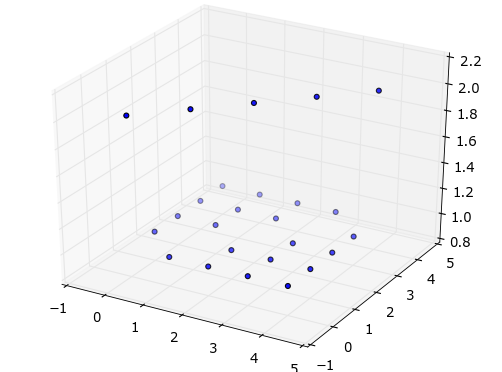
Wireframe plot
1 2 3 4 5 6 7 8 9 10 11 12 13 14 15 16 17 18 19 20 21 22 23 | |
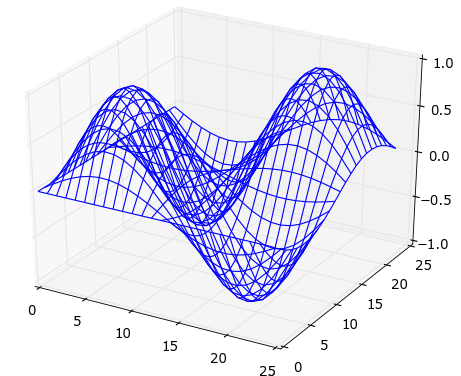
Plot a function
eg. you want a plot of function: f(w) = 5-(w-10)² for w in the range 0..19
import matplotlib.pyplot as plt
x=range(20)
y=map( lambda w: 5-(w-10)**2, x)
plt.plot(x,y)
plt.show()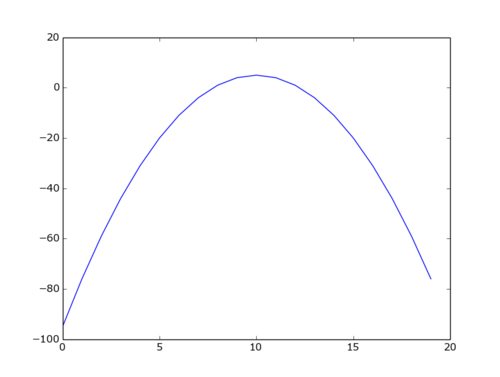
Plot some points
Imagine you have a list of tuples, and you want to plot these points:
l = [(1, 9), (2, 5), (3, 7)]And the plotting function expects to receive the x and y coordinate as separate lists.
First some fun with zip:
print(l)
[(1, 9), (2, 5), (3, 7)]
print(*l)
(1, 9) (2, 5) (3, 7)
print(*zip(*l))
(1, 2, 3) (9, 5, 7)Got it? Okay, let's plot.
plt.scatter(*zip(*pl))
plt.show()